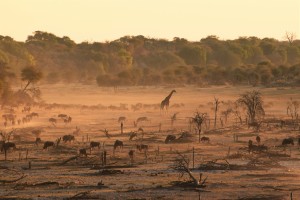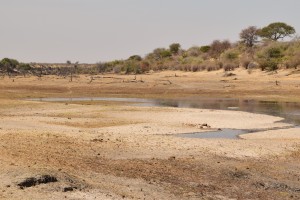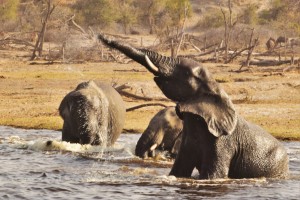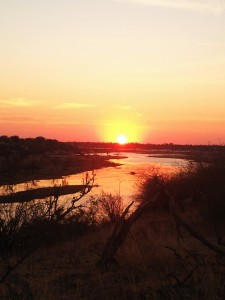
Bots50 – Celebrating 50 Years of Independence in Botswana – By Hayley Blackwell 08 Oct16
October 8, 2016
EfA Festive Fundraiser 2016
November 30, 2016The Return of the Boteti – by Hayley Blackwell 12 Oct 2016
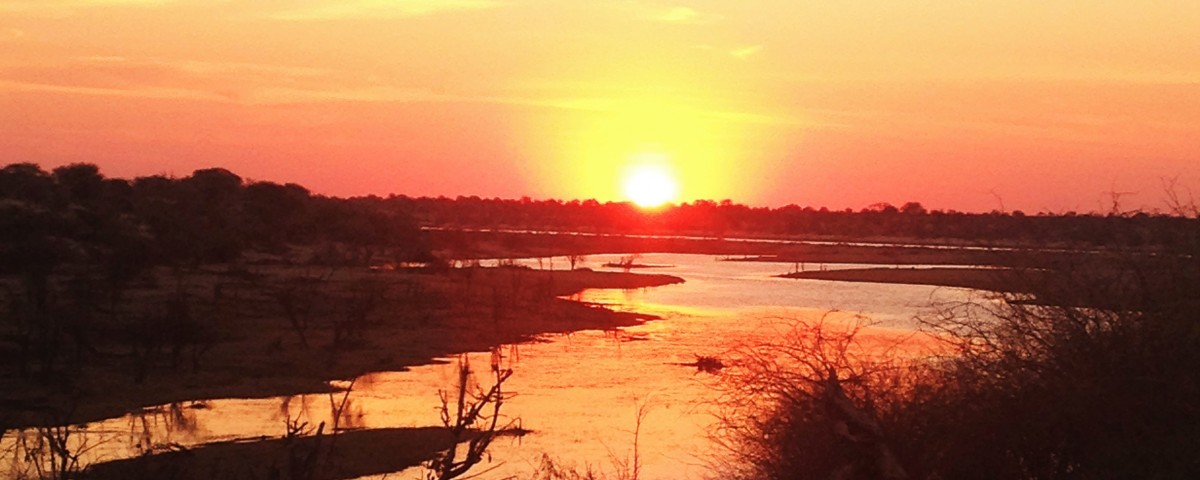
The Boteti River at sunset
When I first arrived in the Makgadikgadi Pans in June, the Boteti River, the only permanent natural water source in the whole national park, had stopped flowing. Usually, at the start of the dry season, the rains that fell in Angola during the rainy season work their way southwards, filling the Okavango Delta, whose
floodwaters overflow into the Boteti’s channel. This means that, remarkably, the river is at its highest level during the dry season. However, this year was different. The rains have been particularly poor here over the past two years, and as such the Boteti had almost dried up completely. Week by week I watched as the amount of water reduced, and the pools got steadily smaller and shallower. Large areas of the river bed became dry and parched, every blade of grass grazed to the ground by large herbivores, turning the landscape dusty and barren.
It is not the first time that this has happened. In 1989 the Boteti dried up and did not flow properly again for the next 20 years. With the return of the river came an influx of male elephants re-colonizing the area,
which was one of the main reasons why Elephants for Africa (EfA) relocated from the Delta to the Makgadikgadi in 2012. This year, as the amount of water, decreased so did the numbers of elephants that we were seeing on our research sessions. Some days we would drive for five hours and not see a single individual! We waited and waited for the floodwaters to reach us, but there were rumours that we would not see them at all this year and we began to worry that we were at the start of another dry spell that could potentially last for many years. If this were the case, would the elephants leave the park for good? And what then for the future of our research?
Finally, at the beginning of August, we heard the news that we had all been waiting for. The river had reached Motopi, a village around 55km upstream of Khumaga and the EfA camp. We were excited and hopeful that this meant we would see the Boteti again this year after all. Yet it had taken a long time for the waters to flow from Maun to Motopi, so we didn’t expect the river to reach us for at least another few weeks, and we were mindful that there may not be a lot of water. But it was better than nothing.
How wrong we were! Less than two weeks later, on 19th August, I was out in the park doing a research
session with Gape and Emily when we received a message from project manager Jess: the river was back! As we were yet to see any elephants that day, we took the decision to abandon the session and rushed to hippo pools, ahead of the oncoming water. I am so glad we did. The whole EfA team spent a wonderful afternoon following the river as it steadily made its way along the western edge of the national park. Everyone was in high spirits as we stood at the very end of the mighty Boteti, dipping our toes into the cool, advancing water and watching as the landscape was transformed before our eyes. We weren’t the only ones relieved to see the return of the river – as we stood there, zebra and wildebeest came streaming down the banks and plunged into the water, wading birds paddled in the shallows and a group of elephants came running to the water’s edge to drink.
The return of the river has created a few logistical challenges – we are no longer able to drive out of the park into Khumaga village to carry out our education and human-elephant conflict mitigation work with the local community. The narrow, shallow stretch of water that we used to drive across is now too deep for the cars. However, at the beginning of this year, EfA became the proud owners of a small boat, thanks to funds raised by Susan Lees and her “In the Footsteps of Elephants” art exhibition. Unfortunately, as the river took somewhat less time than we were expecting to reach the park, the boat was still parked in a yard in Maun when the waters arrived! After a quick trip into town to collect it we were able to take to the water, and have been busy practicing how to pole our way across the river. Learning to control the boat has been a lot of fun, but definitely more difficult than I expected. We have not quite mastered navigating in a straight line yet, but we usually reach our destination eventually!
Since then the Boteti has continued to get wider and deeper. Thankfully the numbers of elephants that we see in the park are increasing, and it never fails to make me smile when we see them splashing and frolicking in the water. The hippos, once confined to the aptly named hippo pools, can now roam further afield, and we often hear them wallowing and grazing at the edge of our camp at night. Green grass shoots are starting to spring up all along the edge of the river and great swathes of aquatic plants are blooming, adding colour to the landscape. The trees alongside the river are also growing new, green leaves, and the camel thorn and apple leaf trees are beginning to flower. The zebra and wildebeest have returned to the river front in much greater numbers, as have a huge array of bird species. With summer just around the corner, the river has brought life back to the Makgadikgadi!

